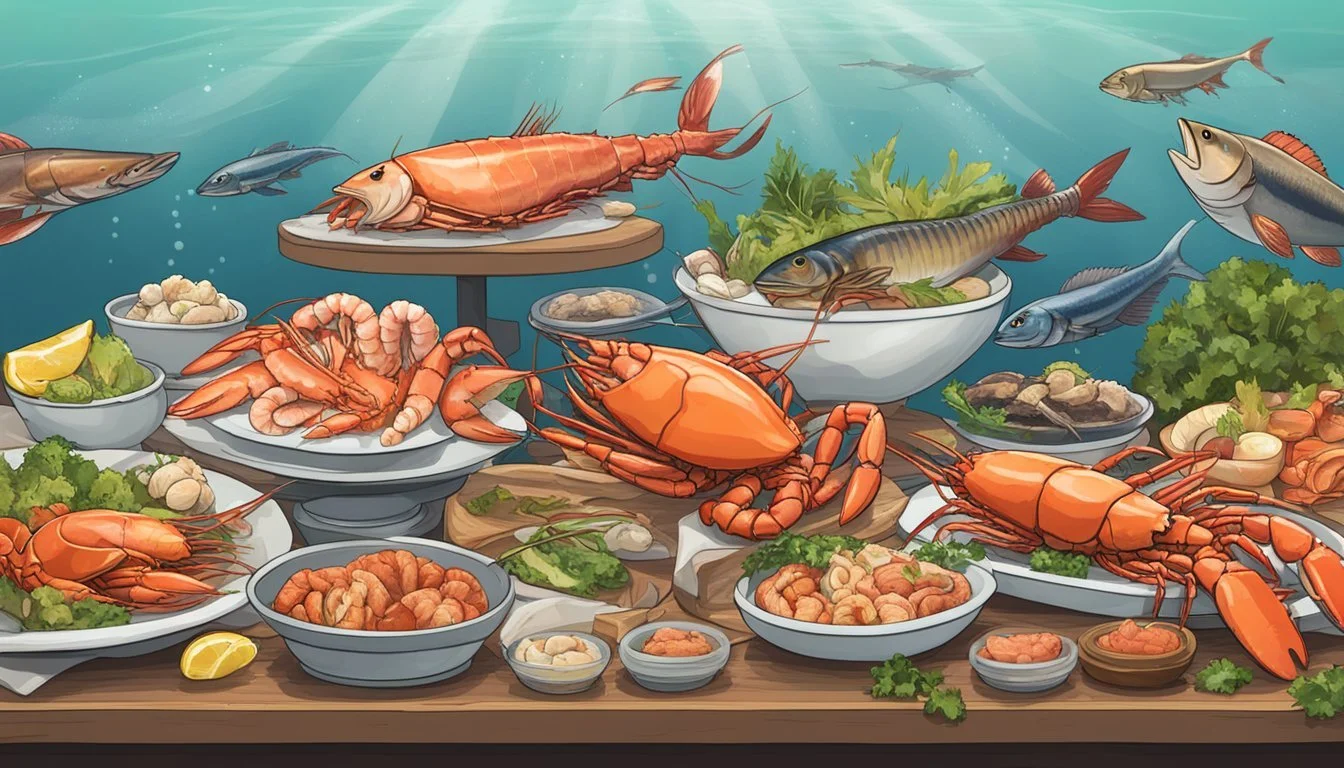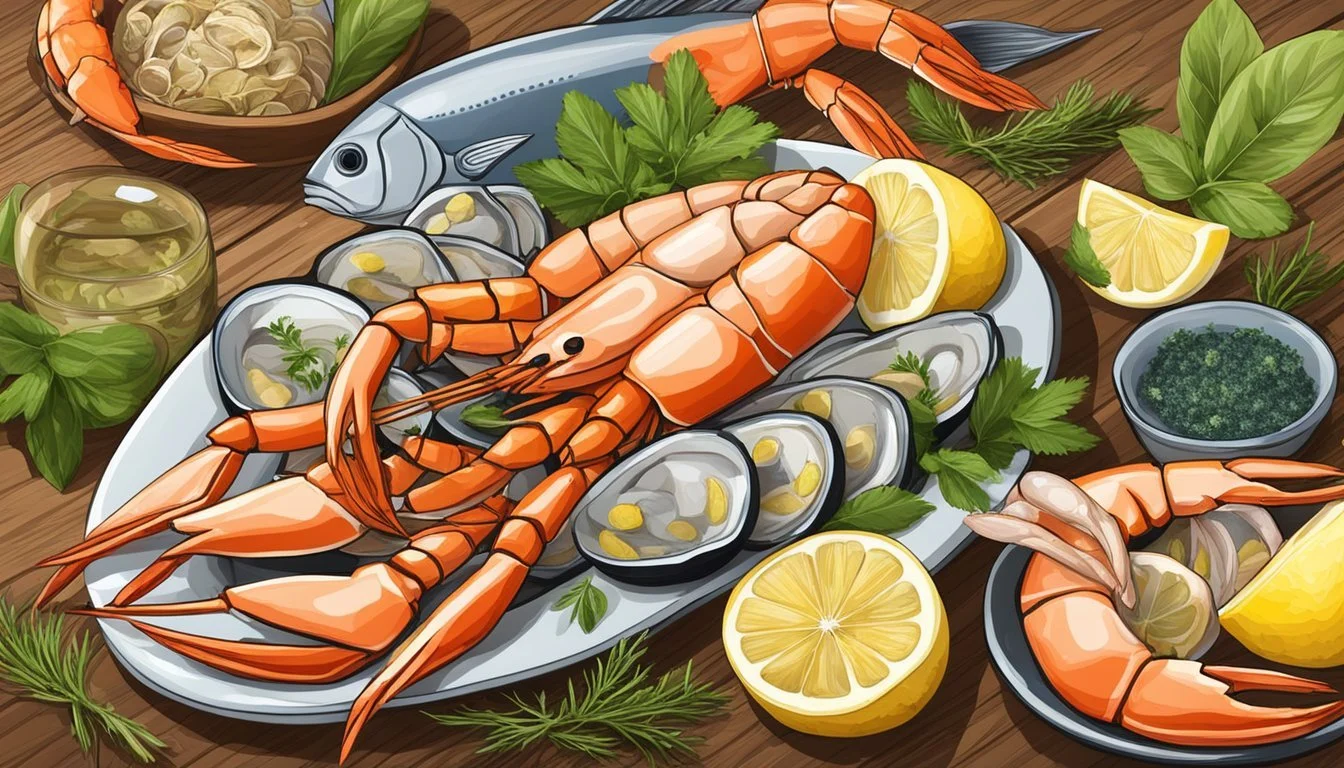MegaMarine
The Ultimate Carnivore's Guide to Seafood Mastery Techniques and Tips
MegaMarine represents a breakthrough for those following a carnivore diet, particularly those eager to embrace seafood. This product offers a comprehensive blend of fish oils formulated to support the gut microbiome while providing essential fatty acids like EPA, DHA, and DPA. For those seeking optimal health with the benefits of fish oil, MegaMarine emerges as an indispensable addition to their nutrition regimen.
The carnivore diet often emphasizes the importance of nose-to-tail eating and including a variety of animal sources. Incorporating seafood can enhance nutrient diversity and provide crucial omega-3 fatty acids. From fish oil supplements like MegaMarine to various seafood recipes, integrating these elements into a carnivore diet can support both health and palate satisfaction.
Understanding how to grill fish perfectly or use innovative techniques like plank grilling adds another layer to mastering seafood-based meals. For example, techniques such as soaking a wooden plank and brushing it with oil before placing fish over a covered grill can impart a smoky flavor, making fish like salmon or trout even more delectable. By mastering these methods, one can elevate their carnivore diet experience with flavorful and nutritious seafood dishes.
Understanding Seafood Nutrition
Seafood is a vital part of a balanced carnivore diet, providing high-quality protein and essential fatty acids while being rich in key vitamins and minerals.
Protein and Essential Fatty Acids
Seafood is renowned for its high-quality protein content. It supports muscle repair and growth, making it a crucial component for those engaged in physical activities. Importantly, seafood proteins are complete, containing all essential amino acids.
Omega-3 fatty acids stand out among the nutrients seafood offers. These fats, found in high amounts in fish like salmon and sardines, are vital for heart and brain health. Studies have shown that regular consumption can reduce inflammation and lower the risk of chronic diseases.
Furthermore, seafood provides an excellent balance of EPA and DHA, two types of omega-3 fatty acids necessary for well-being. The inclusion of seafood in a carnivore diet can thus optimize both physical and mental health through its superior protein and fat composition.
Vitamins and Minerals
Seafood is a powerhouse of essential vitamins and minerals. Vitamin D, found in fatty fish, supports bone health and immune function. It is rare in other food sources, thus making seafood an excellent means to meet daily requirements.
Iodine is another critical mineral provided by seafood, particularly from shellfish and seaweed. It is integral for thyroid function, which regulates metabolism. Additionally, seafood contains selenium, an antioxidant that helps prevent oxidative damage and is essential for thyroid hormone metabolism.
Fish and shellfish are also rich in B vitamins such as B12, which is crucial for nerve function and the production of red blood cells. A diet rich in seafood ensures an adequate supply of these essential nutrients, promoting overall health and preventing deficiencies.
Selecting Quality Seafood
Choosing quality seafood involves knowing the difference between wild-caught and farm-raised options, recognizing certification and sustainability standards, and identifying key freshness indicators.
Wild-Caught vs Farm-Raised
Wild-Caught seafood such as salmon and tuna are sourced from their natural habitats. This method often results in fish with more natural diets, potentially leading to better flavor and texture. However, it can also carry risks like overfishing and inconsistent availability.
Farm-Raised seafood, including shrimp and lobster, is cultivated in controlled environments. This can ensure a more consistent supply and sometimes a lower environmental impact if managed sustainably. It’s important to research farming practices, as some can negatively affect local ecosystems and lead to lower-quality seafood.
Certification and Sustainability
Look for certifications like Marine Stewardship Council (MSC) and Aquaculture Stewardship Council (ASC) when selecting seafood. These labels indicate adherence to sustainable fishing and farming practices. For instance, MSC-certified wild-caught salmon ensures that the fishery meets rigorous environmental standards.
Choosing seafood from sustainable sources helps protect marine ecosystems. Opt for certified scallops, shrimp, and lobster to minimize harmful impacts on marine life. Awareness of these certifications can guide better purchasing decisions, contributing to the health of ocean habitats.
Freshness Indicators
Freshness is crucial for quality seafood. For fish like tuna and salmon, clear eyes, bright red gills, and firm flesh are good indicators. Fresh fish should not have an overly fishy odor; instead, it should smell like the ocean.
For shellfish like scallops and shrimp, look for firm texture and a mild, ocean-like scent. Avoid any that appear slimy or have an off-putting smell. Lobster should be lively if bought live and should have a hard shell.
Using these indicators helps in selecting seafood that is both high quality and safe to consume, ensuring a better dining experience.
The Carnivore Diet and Seafood
Seafood holds a special place within the carnivore diet for its rich nutrient profile and potential health benefits. This section explores how to effectively incorporate seafood, its advantages, and its role in managing specific health conditions.
Incorporating Seafood
Integrating seafood into the carnivore diet is straightforward. Fish, shellfish, and other aquatic animals provide variety and nutritional benefits. Cod, haddock, salmon, and trout are excellent choices.
Grilling techniques vary:
Indirect heat works well for delicate fish like cod. Place the coals around the edge, with a drip pan in the center, and grill over medium heat.
Plank grilling imparts a smoky flavor, ideal for heartier fish like salmon.
Seafood can replace traditional meats a few times a week, ensuring a balanced intake of essential nutrients.
Potential Benefits
Seafood contributes a wide array of health benefits on a carnivore diet. Rich in omega-3 fatty acids, it supports heart health and potentially reduces inflammation. These acids are crucial for brain function and overall cellular health.
Additionally, seafood is a powerhouse of high-quality protein. This protein is vital for muscle repair, growth, and general bodily functions. The diet supports weight loss by keeping individuals full and satisfied, reducing overall calorie intake.
Other notable nutrients include iodine and selenium, which help with thyroid function and immune support, respectively. Together, these benefits make seafood a valuable component of the carnivore diet.
Addressing Health Conditions
Seafood can positively impact various health conditions. For those managing heart disease, incorporating fatty fish like salmon can help lower triglycerides and improve cholesterol levels due to its high omega-3 content.
In the context of diabetes, seafood's low carbohydrate content makes it a suitable choice, potentially helping to stabilize blood sugar levels. Including fish rich in unsaturated fats supports improved insulin sensitivity.
Furthermore, regular consumption of seafood can aid in reducing inflammation, a common issue in chronic diseases. This supports overall health and quality of life, illustrating the practical benefits of integrating seafood into a carnivore diet.
Preparing Seafood
Preparing seafood involves safe handling, effective cooking techniques, and appropriate seasoning to achieve the best taste and texture.
Safe Handling Practices
To ensure seafood remains safe to eat, it must be handled properly from purchase to cooking.
Keep seafood cold by storing it in the refrigerator or on ice. It is important to maintain it at a temperature below 40°F (4°C). When buying fresh seafood, check for firm flesh, clear eyes, and a clean smell.
Always wash hands and utensils with warm, soapy water before and after handling seafood. Prevent cross-contamination by using separate cutting boards for seafood and other foods. Thaw frozen seafood in the refrigerator, not at room temperature, or under cold running water.
Cooking Techniques
Cooking techniques vary based on the type of seafood, each bringing out unique flavors and textures.
Grilling: Brush fish with oil and cook over high heat. Placing fish on a soaked wooden plank can add a smoky flavor.
Pan Searing: Score skin-side of fish, cook skin-side down until crispy, then flip.
Parchment Roasting: Enclose seasoned fillets in parchment and roast gently in the oven.
Ceviche: Marinate seafood cubes in lime or lemon juice for 15-20 minutes, allowing the acidity to "cook" the fish.
Seasoning and Flavoring
Simple seasoning often works best to enhance the natural flavors of seafood.
Use a minimal approach with salt and pepper. A drizzle of olive oil can also enhance the taste. Herbs and citrus such as dill, parsley, lemon, and lime are common choices. For those who enjoy spicier flavors, a dash of hot sauce or a sprinkle of paprika can be added.
When adding fresh ingredients like onions, tomatoes, and cilantro, ensure they complement rather than overpower the seafood's taste.
Remember, the goal is to highlight the natural flavors while introducing subtle enhancements.
Beyond the Basics
Diving deeper into the world of seafood, it is essential to explore nutrient-dense shellfish, lesser-known varieties, and the benefits of consuming seafood nose-to-tail. These practices can enhance nutrition and culinary experiences.
Nutrient-Dense Shellfish
Shellfish such as shrimp and oysters are packed with essential nutrients. Oysters, for example, are a rich source of zinc, which supports immune function and wound healing. They also contain high levels of vitamin B12 and omega-3 fatty acids.
Shrimp are low in calories but high in protein and selenium, which plays a role in antioxidant defense. Emphasizing shellfish in your diet can ensure you get vital micronutrients that might be lacking in other animal proteins. Ensuring freshness and proper preparation techniques will maximize their health benefits and flavor.
Exploring Less Common Varieties
Beyond popular choices like salmon and tuna, there are numerous less-common seafood options to consider. Mackerel, for instance, is an excellent source of omega-3 fatty acids and vitamin D, often found at a lower cost than its more widely consumed counterparts.
Eel is another example, providing a unique texture and a high oil content that makes it ideal for grilling or smoking. Exploring these varieties can diversify your diet and introduce new culinary experiences. Look for sustainably sourced options to support environmental efforts while enjoying these nutritious choices.
Nose-to-Tail Seafood Eating
Nose-to-tail eating involves utilizing all parts of the fish, including organ meats, to minimize waste and maximize nutritional benefits. Fish livers, particularly from cod or monkfish, are rich in vitamins A and D, as well as fatty acids beneficial for heart health.
Incorporating organ meats and bones in soups and stews can increase the intake of minerals like calcium and phosphorus. Techniques such as making fish stock or using fish heads in dishes can contribute to a more sustainable and nutrient-dense diet, ensuring that no part of the fish goes to waste.
Integrating Seafood with Other Diet Approaches
Seafood can complement various dietary approaches by providing essential nutrients and diverse flavors. Some popular approaches include ketogenic, plant-based, and autoimmune protocols.
Ketogenic Compatibility
A ketogenic diet focuses on high-fat, moderate-protein, and low-carbohydrate foods to induce ketosis. Seafood fits well with this approach. Fish and shellfish are naturally low or zero in carbohydrates. Fatty fish like salmon and mackerel are excellent choices due to their high omega-3 fatty acids content. These fats help support ketosis and provide anti-inflammatory benefits. For example, a grilled salmon filet paired with avocado makes a perfect ketogenic meal.
Shellfish such as shrimp and crab also offer rich protein without excess carbohydrates. They can be added to salads or keto-friendly pasta substitutes. Utilizing seafood in a keto diet not only helps maintain ketosis but ensures a robust intake of essential minerals like iodine and selenium.
Seafood in Plant-Based Diets
Incorporating seafood into a primarily plant-based diet can enhance nutrient intake and diversify protein sources. While a strict vegan diet excludes all animal products, some people follow a pescatarian approach, which includes fish and seafood.
Seafood provides nutrients that are harder to obtain from plants alone, such as vitamin B12, DHA (a form of omega-3 fatty acids), and heme iron. Adding seafood like sardines or oysters to a plant-based diet can improve nutritional adequacy, as well as add variety to meals. Moreover, sustainably sourced fish can align with the environmental concerns common among plant-based dieters.
Autoimmune Protocols
Autoimmune Protocols (AIP) aim to reduce inflammation and autoimmunity by eliminating foods that may cause intolerances or sensitivities. Seafood is often a valuable component of AIP because it is typically less likely to trigger autoimmune responses compared to red meat or dairy.
Fish, especially those rich in omega-3 fatty acids, can help manage inflammation. White fish like cod and haddock are particularly gentle on the digestive system. Additionally, seafood is free from gluten and other common allergens that people with autoimmune conditions need to avoid. It's essential to choose wild-caught or sustainably farmed fish to minimize exposure to potential contaminants.
By thoughtfully integrating seafood into these various dietary frameworks, one can enjoy diverse, nutrient-rich meals tailored to their specific health goals.
Addressing Myths and Facts
The carnivore diet, particularly with a focus on seafood, is often misunderstood. It's crucial to clarify common myths related to its environmental impact and health effects.
Environmental Impact
Concerns about the environmental impact of a seafood-based carnivore diet are prevalent. Critics argue that overfishing depletes marine life and disrupts ecosystems. However, sustainable fishing practices exist that can mitigate these effects.
Sustainable fisheries ensure that marine populations remain stable. Wild-caught seafood from certified sources can be a better choice. Aquaculture or fish farming, when responsibly managed, can also provide a sustainable option.
It’s important to choose seafood certified by organizations like the Marine Stewardship Council or Aquaculture Stewardship Council to support environmental efforts. These practices help maintain biodiversity and reduce harmful impacts.
Health Misconceptions
There are several misconceptions about the health implications of a seafood-focused carnivore diet. Some believe it leads to nutrient deficiencies and health conditions due to the exclusion of plant-based foods. This is not necessarily accurate.
Fish oil supplements, like MegaMarine, provide a rich source of omega-3 fatty acids, which are beneficial for heart and brain health. Seafood is also high in protein and essential vitamins like D and B12, promoting overall well-being.
Concern that a lack of fiber could harm gut health is common. Yet, emerging research suggests that a diet rich in omega-3s and balanced nutrients can support a healthy gut microbiome. The key is selecting a variety of seafood to ensure nutrient adequacy.
Experience the convenience and savings of buying fish oil supplement online!
Seafood Throughout History
Seafood has played a crucial role in the diets and cultures of various civilizations. This section provides a clear and concise exploration of how seafood has influenced human history, including cultural significance, evolution of consumption, and the comparison of historical diets.
Cultural Significance
Seafood has held immense cultural importance for many societies.
Ancient Greeks and Romans considered fish a luxury item, often served at elite banquets. In Japan, seafood forms the backbone of traditional diets such as sushi and sashimi. For the Inuit, fish and marine mammals have historically been essential for survival, providing nutrients in their harsh, cold environment. Coastal and island nations continue to rely heavily on seafood, embedding it deeply in their culinary traditions.
Evolution of Seafood Consumption
Human ancestors began consuming seafood around 1.95 million years ago.
The incorporation of fish and shellfish likely provided essential nutrients that supported brain development. By the Middle Ages, the Catholic Church's practice of "fish days" fostered regular seafood consumption across Europe. The advent of refrigeration and global trade in the 19th and 20th centuries expanded access to a variety of seafood, making it a staple in modern diets.
Historical Diets Compared
Comparing historical diets reveals the pivotal role of seafood.
The Mediterranean diet, rich in fish, contrasts with inland European diets that relied more on meat and grains. The Inuit's diet, predominantly consisting of marine life, supplied them with adequate omega-3 fatty acids. Meanwhile, ancient Southeast Asian societies integrated a diverse range of fish and shellfish, showcasing a varied approach to seafood consumption. Each historical diet reflects the geographic and cultural factors influencing food choices.
Building a Comprehensive Seafood Pantry
Properly stocking a seafood pantry requires selecting essential products, ensuring optimal storage conditions, and planning balanced meals. Each component contributes to a diet rich in variety and nutrients.
Must-Have Staples
Stocking a seafood pantry begins with key items, ensuring a mix of fresh and preserved options. Fresh fish varieties like salmon, cod, and haddock are fundamental. Including shellfish such as shrimp, crab, and clams boosts protein intake. Canned seafood like tuna, sardines, and anchovies are also crucial for a long-lasting supply. Additionally, frozen seafood options like scallops and squid offer versatility in meal preparation. Ensure the chosen products meet quality standards and sustainability certifications.
Storage and Preservation
Proper storage maintains the quality and safety of your seafood. Store fresh fish and shellfish in the coldest part of the refrigerator, ideally between 32-38°F. Use airtight containers or vacuum sealers for frozen seafood to prevent freezer burn, keeping your freezer at 0°F. For canned seafood, keep it in a cool, dry place, away from direct sunlight. Label items with purchase dates and rotate stock to use older products first. Preserving methods like smoking and pickling can also extend shelf life while adding unique flavors.
Creating a Balanced Meal Plan
A balanced seafood meal plan includes a variety of products, ensuring nutrient diversity. Incorporate omega-3 rich fish like salmon and mackerel at least twice a week. Pairing lean fish like cod with vegetable sides can create a nutritious, light meal. Use shellfish in stir-fries, salads, or pastas to add texture and protein. Include canned seafood in salads or sandwiches for quick, nutritious meals. Plan meals ahead, considering recipes that utilize different preparation methods such as grilling, baking, and steaming. This approach maximizes flavor and nutritional benefits.
Organize your weekly meals to include a mix of fresh, frozen, and canned options, ensuring that no product goes to waste and every meal is both delicious and nutritious.








